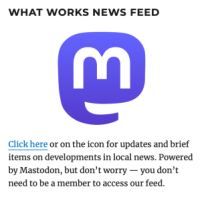
From the moment that Elon Musk bought Twitter in late 2022 and took a wrecking ball to it, millions of appalled users have sought alternatives. Mastodon, a decentralized nonprofit, got some early buzz, though it failed to gain mass traction. Threads, part of the Meta universe, has enjoyed some success, attracting 275 million users; but many of those users are also disenchanted with an algorithm that plays down news and politics.
Now Bluesky is having its moment. The most Twitter-like of the new platforms, Bluesky has experienced a surge of a million new users since the election, attracting the attention of The New York Times, The Associated Press, Slate and others. Its current user base of about 15 million makes it far smaller than Threads, but its customizable feeds, lists and starter packs, as well as its lack of an algorithm, have led many of us to conclude that it’s a better tool for sharing and discussing journalism.
As media writer Oliver Darcy puts it: “But while the masses might be joining Threads, power users in media and politics seem to now be preferring Bluesky. That is where the conversation is now forming. Even on Threads, one of the biggest topics of discussion this week is Bluesky.”
Bluesky got off to a slow start because for quite a long while you could only join by invitation. Former Twitter CEO Jack Dorsey’s involvement was a poison pill for some, though he has since moved on. Today Bluesky is owned by a public benefit corporation — a for-profit company that nevertheless must adhere to some nonprofit-like principles such as “extending benefits to stakeholders like communities and employees,” as Kiplinger puts it.
In other words, Bluesky, unlike Threads and Twitter, is not under the control of an erratic billionaire.
Twitter/X still has nearly 500 million users worldwide, but it has been overrun by trolls, bots and various right-wing extremists, including Musk himself. The Guardian created a stir Wednesday when it announced that it was mostly leaving Twitter, calling it a “toxic media platform.” But many news outlets continue to make heavy use of Twitter.
Six to 10 years ago, when Twitter was at its most useful, it was a gathering place for liberals, conservatives and moderates. Unfortunately, neither Threads nor Bluesky has been able to replicate that vibe, as their user bases are overwhelmingly liberal and progressive. And thus our national discourse continues to become more polarized.
Soon-Shiong comes clean
Patrick Soon-Shiong, the other billionaire newspaper owner who killed an endorsement of Kamala Harris just days before the election, is now saying that his daughter was right all along when she cited Harris’ pro-Israel position in the war in Gaza as the reason that his Los Angeles Times did not weigh in on the presidential race.
“Somebody had asked me, ‘was that the reason?’ I said, ‘well, that wasn’t the only reason.’ Clearly, that was one of the reasons, and there are many other reasons, but I think that should be exposed really transparently about all the reasons,” he told CNN reporters Liam Reilly and Hadas Gold.
Soon-Shiong had previously denied a claim in The New York Times by his daughter, Nika, that the family had decided not to endorse because of Gaza. Instead, he said that he wanted his paper to move away from endorsements, and that he killed the Harris endorsement because the editorial board had ignored his directive to put together a nonpartisan guide to Harris’ and Donald Trump’s stands on the issues.
Now it appears that Soon-Shiong was being less than candid — or, as former LA Times journalist Matt Pearce writes, “Well, Patrick Soon-Shiong lied.” Pearce adds:
If you own large newspaper and have strong opinions about Israel’s war in Gaza, and those opinions about Gaza directly affect how you influence the newspaper’s engagement with politics and the public during an election, then you should probably print your opinion about Gaza in the newspaper you own instead of publicly dumping on your employees and claiming you’d asked them to do some other nonsense that you hadn’t actually asked them to do, and then lying to reporters about your opinions on Gaza not having influenced your political decisionmaking while publicly scolding your daughter for telling the New York Times hey my dad did this because of Gaza, which you followed by writing an internal email to your chief operating officer and executive editor to more or less elaborate at length that hey I did this because of Gaza (feelings which themselves have already gotten watered down in the only-sort-of-coming-clean interview with CNN).
The other billionaire non-endorser, of course, is Jeff Bezos, who canceled a Harris endorsement in The Washington Post at the last minute and claimed he had decided the Post should stop endorsing candidates.
There is a third billionaire non-endorser as well: Glen Taylor of The Minnesota Star Tribune, whose opinion editor announced back in August that the paper would no longer endorse. As my co-author and podcast partner Ellen Clegg wrote for What Works, that was enough to prompt outrage among former Strib opinion journalists, a group of whom published their own Harris endorsement independently.
Please come to Ipswich
If you’re on the North Shore, I’ll be moderating a panel of local-news leaders today at 6 p.m. at the True North Ale Company in Ipswich. The event is free, although donations are requested. Please register here.
The panel is being held to mark the fifth anniversary of Ipswich Local News, whose publisher, John Muldoon, will be a panelist. He’ll be joined by Kris Olson of The Marblehead Current, Erika Brown of The Manchester Cricket and Jack Lawrence of the soon-to-be-launched Hamilton-Wenham News.










 ”
”
